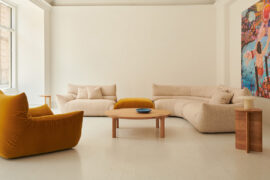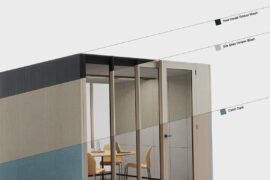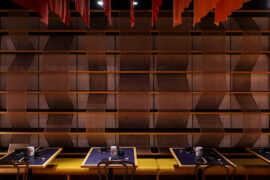When iconic brands wield their influence, the ripples extend far beyond aesthetics. And so when the MillerKnoll collective formed, the very concept of design shifted, supercharging the industry’s aspiration to create a better world into an unwavering sense of responsibility to do so.

April 24th, 2024
A steadfast pledge to design a better world has always driven both Herman Miller and Knoll. Across decades, every creative exploration, design endeavour and product launch has been proudly punctuated by this ethos. But as they teamed up under the helm of MillerKnoll, forming a world-leading design supergroup of unrivalled proportion, resource and influence, this commitment became more tangible than ever before. So much so, it became a duty.
MillerKnoll embraces this responsibility with intentionality, commitment and a sense of urgency. Reflecting the resolute environmental ambitions of the forward-thinking brands that operate as part of the collective, sustainability is one of MillerKnoll’s foundational principles. With over 500 people who come to work each day focused solely on environmental initiatives, MillerKnoll ensures that sustainability continues to be an essential pillar of the company culture, and that a genuine concern for planetary well-being remains at the heart of every business decision and design solution.

This enduring belief that great design has a moral obligation to leave our world better than it was found is enshrined in MillerKnoll’s bold 2030 sustainability targets. The brand’s dedication to confront the climate crisis head on has already earned all of their primary manufacturing, distribution and R&D facilities the esteemed ISO 14001 Certification for environmental performance, and the brand is set to build on these achievements. MillerKnoll is committed to cutting down both their carbon footprint and that of their key suppliers by an impressive 50% – a move that will bring about innovative materials, new processes, and strategic investments in energy efficiency.
Encouraged by the successful 30% reduction in single-use plastic packaging in 2022, MillerKnoll is also meticulously continuing to design waste out – from further reducing their landfill contributions and water use to scrapping the use of single-use plastics completely. In addition, their innovative rePurpose program – focused on resale, recycling and donation of used furniture – has already diverted a staggering 98% of products from landfills, demonstrating MillerKnoll’s outstanding self-awareness in this space.

Sourcing better materials is another essential focal point, and MillerKnoll has committed to ensuring that at least 50% of materials originate from recycled content or responsibly managed sources. To ensure transparency, the organisation shares critical data about the environmental impact of products through Ecomedes, making responsible choices easier for consumers applying for LEED, WELL, and other green certifications.
While these powerful promises and results might sound abstract, the brand pushes the boundaries with tangible actions – and the reimagining of Herman Miller’s legendary Aeron Chair, now integrating ocean-bound plastic, continues to stand out as one of the most compelling examples. Through this initiative alone, more than 150 metric tons of plastic are diverted from the ocean every year (based on an annual sales forecast) in the bid to safeguard marine biodiversity – and redefine the fundamental notion of iconic design as an instrumental vehicle for waste diversion. Embodying the same philosophy, last year Herman Miller’s Eames Shell Chairs and Sayl Chairs used 215 tonnes of recycled plastic. These decisions are further underscored by MillerKnoll’s increasing investment in renewable energy that is transforming their own facilities into beacons of green design on a much larger scale.

These comprehensive achievements and plans – augmented by projects like ‘Gift of Hope’ in Haiti or ‘Trash to Treasure’ in India – reveal MillerKnoll’s deep understanding of the responsibility that comes with the brand’s incredible design legacy. And achievements like WELL Platinum Certification and a top global CSR score from EcoVadis accentuate the fact that MillerKnoll doesn’t merely design objects – it crafts a comprehensive manifesto for a better future.
MillerKnoll’s inspiring attitude serves as a powerful reminder that within the bounds of extraordinary design and global leadership lies genuine potential to heal our planet. By embracing the weight of environmental stewardship as a core principle, MillerKnoll challenges the design industry, proving that beauty, commercial success, and environmental responsibility can not only coexist but form a potent blueprint for a world where design weaves threads of sustainability into the very fabric of our future.
MillerKnoll
millerknoll.com
MillerKnoll Sustainability
millerknoll.com/environmental-social-impact/sustainability


INDESIGN is on instagram
Follow @indesignlive
A searchable and comprehensive guide for specifying leading products and their suppliers
Keep up to date with the latest and greatest from our industry BFF's!

A curated exhibition in Frederiksstaden captures the spirit of Australian design

Now in their 19th year, the Architecture & Design Sustainability Awards are Australia’s leading program dedicated to recognising innovation and excellence in sustainable architecture and design.

The independent Master Jury of the 16th Award Cycle (2023-2025) has selected seven winning projects from China to Palestine.
The internet never sleeps! Here's the stuff you might have missed

A new online space offers designers enhanced tools, resources and real-time customisation.

Designed by Kelly Ross, the newest addition to Bisa Hospitality’s portfolio represents more than just another restaurant opening.